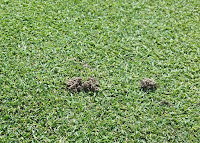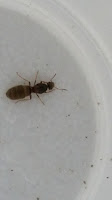A brutal stretch of rain, heat and humidity is looking like it is coming to an end. Within the last week, the golf course has received over 6.5" of rain, and more is pouring down as I write this. Many areas to the west of Elcona have received double the amounts we have, so I count my blessings that rainfall has not been greater. I would like to take a moment and explain what is causing what everyone is observing out on the course, mainly on the greens.
Soil conditions now course wide are quite saturated and currently cannot handle even small amounts of water quickly. Combine these water logged soils with daytime highs in the mid to upper 80's and heat indexes approaching 100 degrees, and it does not take long to create soil temperatures above 85 degrees. These conditions create prime environments for disease and turf struggles, as roots begin to die off and they do not come back until soil temperatures consistently stay below 80. Roots and turf that do not die off are quite easily susceptible to fungal diseases.
 |
| Canopy temperature on 2 green, one day after a 4.5" rain event. This is not good! |
 |
| Pythium effects, 8 green |
The brown areas of turf on some of the greens are areas that have succumbed to Pythium Root Rot. This disease affects mainly the creeping bentgrass in the greens, as the healthy Poa annua surrounding it depicts. With the weather and extreme soil temperatures we have experienced in the last 6 weeks, extreme environmental stress has finally shown us the symptoms of probable infection that occur during late spring. We have treated all greens twice with fungicides to combat this pathogen, and a third will be coming this week. A regularly scheduled venting of the greens is also coming Monday, which will allow us to poke .25" x 5" deep holes into the greens surface to dry out the rootzone and allow it to drain better, as well as promote new rooting and replacing harmful carbon dioxide in the soil with fresh oxygen. The good news is that I am seeing new plant tissue emerge from many of these brown areas, a sign that the disease is in check and recovery is coming, which will be helped tremendously by the cooler weather coming this week.
 |
| Pythium effects, 3 green |
Please note that recovery will take some time in these areas. Any areas that do not recover will be plugged out from our nursery. We have two large bentgrass/Poa nurseries that were established mainly plugs taken from our greens. These nurseries are maintained exactly the same as the greens on the golf course and are an invaluable asset to have on hand.
Many of the collar edges and higher trafficked areas around the greens have also succumbed to the extreme stresses and traffic that the last 6 weeks have brought. Populations of our old friend Poa trivialis (roughstalk bluegrass) that have emerged in the approaches have gone dormant from this weather. Again, I am seeing new plant tissue emerging from these areas, so recovery is ongoing.
 |
| Rough bluegrass, April 30th on 11 approach |
 |
| Same patch 8/12/16 |
While I am not satisfied by any stretch with these current issues and conditions, the overall health of the golf course is good. We will continue to be diligent with our maintenance practices to aid recovery and utilize all means available to return normal playing conditions as soon as possible.
Finally, we lost a quarter of the large Burr Oak near 5 green (affectionately known as "Gus") Saturday morning. This tree is estimated to be about 250 years old, and there are many cables that have been installed over the years to stabilize and balance its weight. This morning one of the cables snapped, causing the southeast part of the tree to fall. It has since been re-cabled and stabilized, but the area will be roped off to cart traffic for the time being.
If you have any questions, or would like to discuss the topics I mentioned above with me, please contact me at ryan@elconacc.com, or call me at my office. I am more than happy to discuss and explain what is happening on the course with you.
Ryan




















